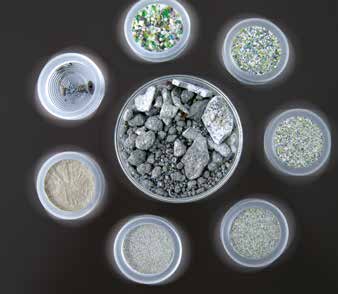Prospects in the Recycling Economy
Be it rubble, scrap wood, waste incineration slag, carbonfiber-reinforced composite materials or electronic scrap, several million tonnes of these types of waste are produced worldwide every year. The Fraunhofer Institute for Building Physics conducts research on the method of electrodynamic fragmentation for the recycling of composite materials. The method is based on the principle that ultra-short (<500 nsec) underwater impulses cause selective fragmentation of composite materials. The electrical discharge runs along phase boundaries, thus disassembling the composite material into its components. The advantage of this method is a dust- and contamination-free separating process and, unlike in a mechanical process, no abrasion occurs.
Concrete is the most commonly used building material in the world. It is made of cement, water and aggregate like gravel or limestone with different sized grains. Mineral construction waste amounted to a total of 186.5 million tonnes in 2010, 53.1 million tonnes of which was rubble (this corresponds to 28.5 percent). Up to now, concrete rubble has produced enormous amounts of dust when crushed, and it mainly ends up as a sub-base for roads. However, with electrodynamic fragmentation, construction and demolition waste can be recycled to produce high-quality aggregates for the production of fresh concrete and a raw material for the production of cement.
Fraunhofer scientists see great potential in the recycling of waste incineration slag. 420 million tonnes of this material is produced worldwide every year. Applying electrodynamic fragmentation would not only preserve increasingly scarce landfill space but also attain a considerably higher recovery rate of valuable secondary raw materials and metals.
An additional area of application is the aviation industry. The increasing installation of carbon-fiber-reinforced polymers in aircraft calls for a recycling technology that conserves important resources and reintroduces recycled carbon fibers into new products in an economical manner. The same applies to electronic scrap as well as many other composite materials that, up to the present, could not be disassembled cleanly enough or not at all.
Parallel to the development of the process, scientists are creating an ecological balance sheet for the product system of every method developed in the Fraunhofer-internal project “Molecular Sorting“. The obtained information is fed back to the developers in several iteration loops. The end result is processes in which ecological analyses play a key role.
 Fraunhofer Group for Materials and Components - Materials
Fraunhofer Group for Materials and Components - Materials